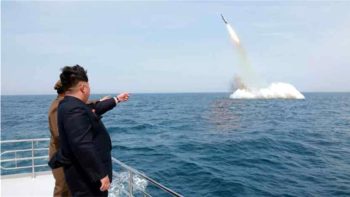
Nuclear-armed North Korea launched four ballistic missiles on Monday in another challenge to President Donald Trump, with three landing provocatively close to America’s ally Japan.
Seoul and Washington began annual joint military exercises last week that always infuriate Pyongyang, with the North’s military warning of “merciless nuclear counter-action”.
Under leader Kim Jong-Un, Pyongyang has ambitions to develop an intercontinental ballistic missile (ICBM) capable of reaching the US mainland — something which Trump has vowed will not happen.
Seoul said four missiles were fired from Tongchang County in North Pyongan province into the East Sea — its name for the Sea of Japan.
The missiles travelled around 1,000 kilometres (620 miles) and reached an altitude of 260 kilometres, said a spokesman for South Korea’s Joint Chiefs of Staff, adding they were unlikely to be ICBMs.
Regional and world powers lined up to condemn the launches.
Japanese Prime Minister Shinzo Abe said three of the North Korean missiles came down in Tokyo’s Exclusive Economic Zone (EEZ) — waters extending 200 nautical miles from its coast.
“This clearly shows North Korea has entered a new stage of threat,” Abe told parliament.
The North’s repeated launches “clearly violate UN Security Council resolutions”, he said. “We can never tolerate this.”
Pyongyang carried out two atomic tests and a series of missile launches last year, but Monday was only the second time its devices had entered Japan’s EEZ.
After an emergency meeting of South Korea’s National Security Council, acting president Hwang Kyo-Ahn called the North’s nuclear and missile provocations “immediate and real threats” to his country.
“Considering the North Korean leadership’s brutality and recklessness shown through the murder of Kim Jong-Nam, the results of the North having a nuclear weapon in its hands will be gruesome beyond imagination,” he said.
Seoul has blamed Pyongyang for the killing of the half-brother of the North’s leader by two women using VX nerve agent at Kuala Lumpur International Airport last month.
Malaysia has expelled the North’s ambassador over the incident and the envoy flew home Monday. Pyongyang responded by formally declaring the Malaysian envoy persona non grata.
Hwang called for “swift deployment” of a US missile defence system, THAAD, a proposal which has infuriated neighbouring China, the North’s key diplomatic protector and main provider of trade and aid.
– ‘Big, big problem’ –
In Washington, the State Department condemned the launches, saying the US was ready to “use the full range of capabilities at our disposal against this growing threat”.
“We remain prepared — and will continue to take steps to increase our readiness — to defend ourselves and our allies from attack,” acting spokesman Mark Toner said in a statement.
Monday’s launch came ahead of a trip to Japan, China and South Korea by new US Secretary of State Rex Tillerson this month, pointed out Dongguk University professor Kim Yong-Hyun.
Pyongyang was “trying to send a message early on in Trump’s term that North Korea will not be dragged around by his administration”, he said.
The North is barred under UN resolutions from any use of ballistic missile technology.
But six sets of UN sanctions since Pyongyang’s first nuclear test in 2006 have failed to halt its drive for what it insists are defensive weapons.
Three years ago, Barack Obama ordered the Pentagon to increase cyber attacks against North Korea to try to sabotage its missiles before launch or just as they lift off, the New York Times reported at the weekend.
Several of the North’s devices have failed soon after launch.
Kim Dong-Yup, an analyst at the Institute for Far Eastern Studies at Kyungnam University, noted that unlike previous launches the three missiles that reached Japan’s EEZ were fired in different directions.
“North Korea may have attempted to show it can strike US bases in Japan simultaneously,” he said.
Trump has described the North as a “big, big problem” and vowed to deal with the issue “very strongly”.
– ‘Exercise restraint’ –
Monday’s missile firings were unlikely to be testing a newly developed device but were aimed instead at protesting the military drills in the South, analysts said.
Seoul and Washington launched the annual Foal Eagle exercises last week.
North Korea has regularly taken action to protest against the drills, firing seven ballistic missiles during the exercises last year.
Beijing has become increasingly frustrated with Pyongyang’s nuclear and missile activities, and last month announced a suspension of all coal imports from the North until the end of the year — a crucial source of foreign currency.
China’s foreign ministry said it remained opposed to missile launches by the North that violate UN resolutions, but also voiced concern about the military exercises.